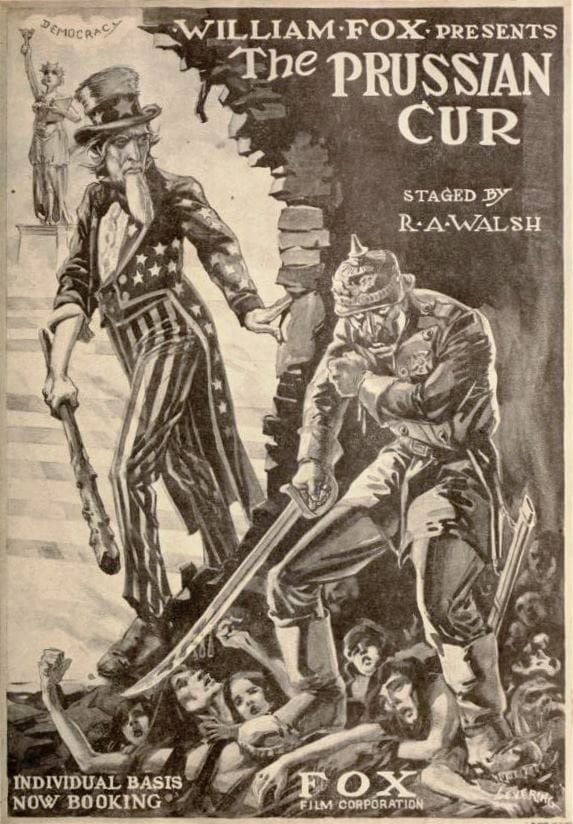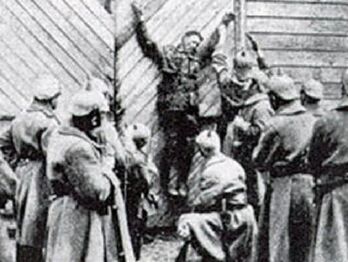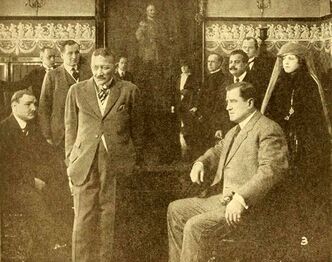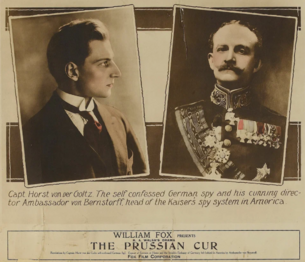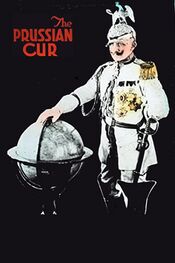The Prussian Cur (lost silent World War I anti-German propaganda film; 1918): Difference between revisions
(NW) |
No edit summary |
||
| (7 intermediate revisions by 3 users not shown) | |||
| Line 1: | Line 1: | ||
{{ | {{InfoboxLost | ||
|title=The Prussian Cur | |title=<center>The Prussian Cur</center> | ||
|image=TPCposter.jpg | |||
|imagecaption=The film's theatrical poster. | |||
|status=<span style="color:red;">'''Lost'''</span> | |||
|image= | |||
|imagecaption= | |||
|status= | |||
}} | }} | ||
'''''The Prussian Cur''''' is an anti-German silent propaganda film produced by Fox in 1918 following America's entry into World War I. Directed by prolific silent film director Raoul Walsh, it was similar to other contemporary war films such as ''Hearts of the World'' and ''The Kaiser, the Beast of Berlin''.<ref name=EH>[https://archive.org/details/exhibitorsherald07exhi The Exhibitors Herald from Jun-Sep 1918 mentioning ''The Prussian Cur''.] Retrieved 18 Apr '23</ref> Due to the 1937 Fox vault fire likely destroying all copies, the film is now considered lost. | |||
The Prussian Cur is | |||
==Plot== | |||
The film depicts a war-hungry Kaiser Wilhelm (played by Walter M. Lawrence) unleashing waves of submarine attacks in Atlantic which devastate shipping and culminates in the sinking of the Lusitania. Meanwhile, German spies in America work to sabotage railways and factories, support German sympathetic Americans, and stir up civil unrest. | |||
The | The film's protagonist Dick Gregory (played by Sidney Mason) flushes out German spies led by Otto Goltz (played by Horst von der Goltz) and leads a group of patriots against the German subversion. During this counterintelligence, Goltz marries an American woman, Lillian O'Grady (played by Miriam Cooper), who is treated so poorly she is driven to her death. Supported by the home front victory, American soldiers eventually flood into Europe, freeing the continent as the Kaiser's plans crumble around him and he dies.<ref name=EH>[https://archive.org/details/exhibitorsherald07exhi The Exhibitors Herald from Jun-Sep 1918 mentioning ''The Prussian Cur''.] Retrieved 18 Apr '23</ref> | ||
The film is | The film is also famous for depicting the story of the "Crucified Canadian", a popular piece of atrocity propaganda during the war, regarding the purported "crucifixion" of a Canadian soldier against a barn using bayonets by German soldiers.<ref>[https://www.dailytelegraph.com.au/anzac-centenary/angel-of-mons-a-crucified-canadian-and-the-kadaver-factory-mysteries-and-spin-of-world-war-one/news-story/5e144bcc5cc55f82513dfa4fa5cada8d A Daily Telegraph article featuring a frame of the "Crucified Soldier" scene.] Retrieved 18 Apr '23</ref> | ||
The | ==History== | ||
''The Prussian Cur'' was directed by Raoul Walsh, with guidance from the U.S. Committee on Public Information, and starred Miriam Cooper as Lillian O' Grady, Sidney Mason as Dick Gregory, and Horst von der Goltz as Otto Goltz. The film was produced in Fort Lee, New Jersey, where the Fox Film Corporation was based.<ref>[https://web.archive.org/web/20110425014840/http://www.fortleefilm.org/studios.html The Fort Lee Film Comission listing ''The Prussian Cur''.] Retrieved 18 Apr '23</ref> | |||
Several film stills and pieces of advertising materials have survived but no copy of the film is known to exist. The only existing copies | After its release, the film was considered exploitative, propagandizing, and jingoistic, even for the time. Both Walsh and Cooper later disowned the film and expressed regret over participating in its production. The film also was affected heavily by censor boards, with the Chicago Board of Censors requesting cuts such as the interstitial "Kill the men and save the women for yourselves!" and a scene where a German soldier takes off his coat in a bedroom.<ref name=EH>[https://archive.org/details/exhibitorsherald07exhi The Exhibitors Herald from Jun-Sep 1918 mentioning ''The Prussian Cur''.] Retrieved 18 Apr '23</ref> | ||
==Availability== | |||
Several film stills and pieces of advertising materials have survived but no copy of the film is known to exist. The only existing copies were likely destroyed in the 1937 Fox vault fire in Little Ferry, New Jersey, where many of Fox's early silent films, including ''The Prussian Cur'', were stored. | |||
==Gallery== | |||
<gallery mode="packed" heights="175px"> | |||
Theprussiancurstill.jpg|Surviving still of the infamous "Crucified Canadian" scene. (1/2) | |||
TPCstill2.jpg|Surviving still. (2/2) | |||
TPClobbycard.png|Lobby card. | |||
TPCalt.jpg|Alternate poster. | |||
</gallery> | |||
==External Links== | |||
*[https://www.imdb.com/title/tt0009524/plotsummary/?ref_=tt_ov_pl IMDb page for ''The Prussian Cur''.] | |||
==References== | |||
{{reflist}} | |||
[[Category:Lost films|Prussian Cur]] | |||
[[Category:Completely lost media|Prussian Cur]] | |||
Latest revision as of 15:15, 30 May 2023
The Prussian Cur is an anti-German silent propaganda film produced by Fox in 1918 following America's entry into World War I. Directed by prolific silent film director Raoul Walsh, it was similar to other contemporary war films such as Hearts of the World and The Kaiser, the Beast of Berlin.[1] Due to the 1937 Fox vault fire likely destroying all copies, the film is now considered lost.
Plot
The film depicts a war-hungry Kaiser Wilhelm (played by Walter M. Lawrence) unleashing waves of submarine attacks in Atlantic which devastate shipping and culminates in the sinking of the Lusitania. Meanwhile, German spies in America work to sabotage railways and factories, support German sympathetic Americans, and stir up civil unrest.
The film's protagonist Dick Gregory (played by Sidney Mason) flushes out German spies led by Otto Goltz (played by Horst von der Goltz) and leads a group of patriots against the German subversion. During this counterintelligence, Goltz marries an American woman, Lillian O'Grady (played by Miriam Cooper), who is treated so poorly she is driven to her death. Supported by the home front victory, American soldiers eventually flood into Europe, freeing the continent as the Kaiser's plans crumble around him and he dies.[1]
The film is also famous for depicting the story of the "Crucified Canadian", a popular piece of atrocity propaganda during the war, regarding the purported "crucifixion" of a Canadian soldier against a barn using bayonets by German soldiers.[2]
History
The Prussian Cur was directed by Raoul Walsh, with guidance from the U.S. Committee on Public Information, and starred Miriam Cooper as Lillian O' Grady, Sidney Mason as Dick Gregory, and Horst von der Goltz as Otto Goltz. The film was produced in Fort Lee, New Jersey, where the Fox Film Corporation was based.[3]
After its release, the film was considered exploitative, propagandizing, and jingoistic, even for the time. Both Walsh and Cooper later disowned the film and expressed regret over participating in its production. The film also was affected heavily by censor boards, with the Chicago Board of Censors requesting cuts such as the interstitial "Kill the men and save the women for yourselves!" and a scene where a German soldier takes off his coat in a bedroom.[1]
Availability
Several film stills and pieces of advertising materials have survived but no copy of the film is known to exist. The only existing copies were likely destroyed in the 1937 Fox vault fire in Little Ferry, New Jersey, where many of Fox's early silent films, including The Prussian Cur, were stored.
Gallery
External Links
References
- ↑ 1.0 1.1 1.2 The Exhibitors Herald from Jun-Sep 1918 mentioning The Prussian Cur. Retrieved 18 Apr '23
- ↑ A Daily Telegraph article featuring a frame of the "Crucified Soldier" scene. Retrieved 18 Apr '23
- ↑ The Fort Lee Film Comission listing The Prussian Cur. Retrieved 18 Apr '23
